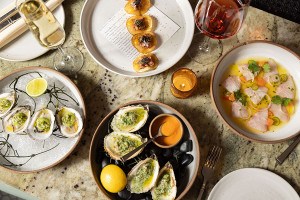A Second Look At Petruce et al: The State Of The Markup
My review of the fantastic Petruce et al came out last week, and it kicked off a small but welcome debate. The question: Is the restaurant’s wine “pricey”—and what, exactly, does “pricey” mean?
Let’s start with the second part of the question, which I’d actually tried to answer in my review. “Wine is pricey at triple retail,” I wrote, “but there’s value in [sommelier Tim] Kweeder’s offbeat three- and five-ounce pours, which aren’t marked up any further.”
Commenter JM objected to my characterization—marshaling actual evidence (a rare and exemplary addition to any online comments thread). He provided the Pennsylvania retail prices, as well as Petruce’s list prices, for the restaurant’s white wines. The markups ranged from 2.19x to 3x.
“Hmmm, triple retail?” he asked. “I don’t think so.” (JM also disclosed that he sells wine in Pennsylvania, including to Petruce—a useful bit of information that may have helped set the civil tone that reigned over subsequent comments.)
After reading JM’s remarks, I looked at Petruce’s wine list and discovered two things: 1) The current red and rosé bottles follow the same pattern JM noted (with markups averaging about 2.6x), and 2) Tim Kweeder’s wine list has changed a ton in the weeks since I ate my review meals. Which is terrific—a sign of an enthusiastic sommelier.
At any rate, to JM’s question, “Did you do the math even?” the answer is that, indeed, I did. I calculated the markups for about 8 or 10 bottles—which was not the whole list, but a decent sample of it—and the results were mostly around triple retail. Unfortunately, I no longer have the paper copy of that list, so I can’t go back and check my work. (Although I expect that Philly Mag’s excellent fact-checker did it at the time.) Whatever the case, clearly there are two possibilities: my math was skewed by an unwitting selection of the most-marked-up bottles, or Kweeder has brought his prices down a little bit. If the former, I apologize. If the latter, I applaud.
But that’s not where the discussion ends, nor should it.
For one thing, these markup factors don’t include gratuity, which makes a big difference. With a 20 percent tip, a 2.19x markup becomes 2.63x, and a 3x markup rockets to 3.6x.
JM’s tone suggests that he considers these markups fair. Yet the very next commenter opines, “If you pay those prices you should punch yourself in the throat afterwards.” Then commenter Mick complicates the discussion by asking, “Why do people gladly pay 3x+ for beer or liquor, but when it is wine, you feel ripped off?”
I like that question. And though I definitely don’t count myself as one who “gladly” pays 3x+ markup for anything, here’s my own answer: I get markups on beer, especially draft beer. Beer requires more space, on a per-drink basis, than wine or liquor, and it also entails a higher refrigeration cost. Space is costly, especially in Center City. Draft beer carries additional costs: like cleaning and maintaining the tap system, and managing the special delivery and return of kegs.
Liquor is on the other end of the spectrum: it’s maximally space efficient, doesn’t require refrigeration—and for the most part, doesn’t go bad once you’ve opened a bottle. For these reasons, paying hefty mark-ups on straight liquor seems like the worst rip-off around. (Newfangled whiskey bars, I’m looking straight at you.)
Liquor in cocktails, however, deserves an exception—although just how big of one depends on the cocktails. All cocktails require at least some effort, if only to measure and mix them. But the city’s best cocktail programs involve even more effort—homemade bitters, infused and/or barrel-aged spirits, that sort of thing. This labor, like all labor, merits fair payment.
Which brings us to wine. With wine, all the labor’s already in the bottle, so that’s no justification for a markup. There is some expertise involved in selecting a list, on the other hand, so that’s added value. And wine does need climate control, and will go bad after you open it, which explains the typical premium for ordering it by the glass (and my pleasure that Kweeder avoids charging one at Petruce).
So, what’s a fair wine markup? The more I’ve thought about it, the more convinced I have become of two things.
Number one, every answer is arbitrary. I’ve always considered double retail to be reasonable—because that’s what my dad thought. For all I know, JM’s dad pegged it at 2.5x—and his mother was fine with paying 3x. Inherited assumptions play a large role in our expectations, as in every facet of life and culture.
But number two, multiplying a wine’s retail price by some factor is not the only way to do things. Some restaurants charge a flat per-bottle fee, for instance, which has always made more intuitive sense to me.
And do you know what makes more sense? Not relying on wine, or alcohol in general, to generate the lion’s share of your profits. Because why should a restaurant sell a scallop appetizer for twice the cost of its ingredients—laboriously transformed into a delicious dish by who knows how many prep cooks and sous chefs—but charge three times the cost of a wine bottle (or $41 more than retail on the least-marked-up bottle JM noted on Petruce’s list) for the service of storing and opening it?
I can think of answers–ranging from the high cost of liquor licenses in Philadelphia to the Puritanical view of alcohol dating back colonial America–but none of them prevent a local restaurateur from innovating in the wine-markup department. In the meantime, I’m going to try to find space in my reviews to note average wine markups as a matter of course, right along with entrée prices. That way customers will know what to expect–and perhaps restaurateurs will be motivated to compete on price for diners looking to get the most bang for their drinking buck.
Petruce et al [Philly mag review]


